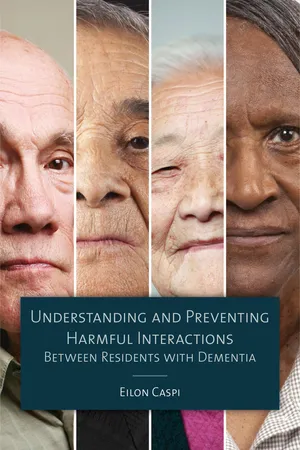
eBook - ePub
Understanding and Preventing Harmful Interactions Between Residents with Dementia
- English
- ePUB (mobile friendly)
- Available on iOS & Android
eBook - ePub
Understanding and Preventing Harmful Interactions Between Residents with Dementia
About this book
Professional care providers can learn ways to avoid one of the most challenging and costly problems to occur in care settings: Interactions between residents that lead to serious harm. Most of these episodes are preventable. Understanding what may provoke a person with dementia to respond in a physically or verbally harmful manner is the key to prevention and mitigation.
This book provides the first care standard for the field, presenting practical tools and instruction on how to identify contributing factors, causes, unmet needs, and triggers that commonly lead to serious distress or injury, sometimes even death. Emphasizing compassionate, person-directed care practices, author Eilon Caspi describes strategies for preventing and de-escalating situations before, during, and after harmful resident-to-resident interactions. Dozens of real-life examples are included. Based on extensive research and proven behavioral analysis, this valuable resource:
• Identifies dozens of factors that contribute to harmful interactions
• Describes which factors can be modified and which cannot, and how to work with them either way
• Creates opportunities to improve resident and staff well-being and safety
• Delivers a wealth of useful intervention tools and strategies
• Provides access to downloadable assessment and planning tools with detailed instructions on how to use them
This critical resource will inform training programs and daily practice for direct care staff, interdisciplinary care teams, and long-term care administrators. The recommended approaches will help providers meet federal nursing home regulations, avoid unnecessary legal liabilities, and enjoy cost savings from reduced resident-to-resident incidents. A safer and more harmonious experience can be achieved for all who live or work in care homes.
This book provides the first care standard for the field, presenting practical tools and instruction on how to identify contributing factors, causes, unmet needs, and triggers that commonly lead to serious distress or injury, sometimes even death. Emphasizing compassionate, person-directed care practices, author Eilon Caspi describes strategies for preventing and de-escalating situations before, during, and after harmful resident-to-resident interactions. Dozens of real-life examples are included. Based on extensive research and proven behavioral analysis, this valuable resource:
• Identifies dozens of factors that contribute to harmful interactions
• Describes which factors can be modified and which cannot, and how to work with them either way
• Creates opportunities to improve resident and staff well-being and safety
• Delivers a wealth of useful intervention tools and strategies
• Provides access to downloadable assessment and planning tools with detailed instructions on how to use them
This critical resource will inform training programs and daily practice for direct care staff, interdisciplinary care teams, and long-term care administrators. The recommended approaches will help providers meet federal nursing home regulations, avoid unnecessary legal liabilities, and enjoy cost savings from reduced resident-to-resident incidents. A safer and more harmonious experience can be achieved for all who live or work in care homes.
Frequently asked questions
Yes, you can cancel anytime from the Subscription tab in your account settings on the Perlego website. Your subscription will stay active until the end of your current billing period. Learn how to cancel your subscription.
At the moment all of our mobile-responsive ePub books are available to download via the app. Most of our PDFs are also available to download and we're working on making the final remaining ones downloadable now. Learn more here.
Perlego offers two plans: Essential and Complete
- Essential is ideal for learners and professionals who enjoy exploring a wide range of subjects. Access the Essential Library with 800,000+ trusted titles and best-sellers across business, personal growth, and the humanities. Includes unlimited reading time and Standard Read Aloud voice.
- Complete: Perfect for advanced learners and researchers needing full, unrestricted access. Unlock 1.4M+ books across hundreds of subjects, including academic and specialized titles. The Complete Plan also includes advanced features like Premium Read Aloud and Research Assistant.
We are an online textbook subscription service, where you can get access to an entire online library for less than the price of a single book per month. With over 1 million books across 1000+ topics, we’ve got you covered! Learn more here.
Look out for the read-aloud symbol on your next book to see if you can listen to it. The read-aloud tool reads text aloud for you, highlighting the text as it is being read. You can pause it, speed it up and slow it down. Learn more here.
Yes! You can use the Perlego app on both iOS or Android devices to read anytime, anywhere — even offline. Perfect for commutes or when you’re on the go.
Please note we cannot support devices running on iOS 13 and Android 7 or earlier. Learn more about using the app.
Please note we cannot support devices running on iOS 13 and Android 7 or earlier. Learn more about using the app.
Yes, you can access Understanding and Preventing Harmful Interactions Between Residents with Dementia by Eilon Caspi in PDF and/or ePUB format, as well as other popular books in Medicine & Diseases & Allergies. We have over one million books available in our catalogue for you to explore.
Information
Topic
MedicineSubtopic
Diseases & AllergiesTable of contents
- Cover
- Title Page
- Copyright
- Dedication
- Contents
- About the Author
- Acknowledgments
- Foreword—Paul Raia
- Foreword—Christa Hojlo
- Preface
- Introduction
- Part I. Scope of DHRRIs and Guiding Principles
- Part II. Contributing Factors, Causes, and Triggers
- Part III. Prevention and De-escalation Strategies
- References
- Index